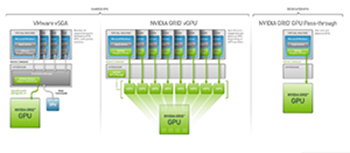News
New Options for VMware VDI Announced at VMworld 2015
Technology introduced at this year's virtualization conference upgrades the end-user desktop experience.
Choosing the right graphics configuration for your VMware View virtualized desktops can greatly increase the experience of your end users. VMware offers many graphics options from which to choose. VMware graphics options can be separated into five different categories, two in software and three that take advantage of hardware-based GPUs.
VMware has offered a basic software-defined GPU since its ESXi inception, and it's currently being used in millions of virtual machines (VMs) worldwide. But VMware's basic software GPU has limitations and doesn't have the features needed for most virtual desktops if they're doing anything but the simplest graphics tasks. To mitigate these limitations, VMware has evolved over the years and come up with graphics solutions where now even the most extreme graphics-intensive applications can be run in a virtual desktop.
Soft 3D, introduced with View 5.0., creates a software GPU that doesn't take advantage of a hardware GPU, but still allows the running of Windows 3D Aero desktops on ESXi. Soft 3D is a good solution for running general office applications that have limited graphics needs as it's limited in graphics processing power and only supports DirectX 9.0c and OpenGL 2.1. VMware supplies the driver for Soft 3D with its VMware tools package.
With View 5.2, VMware came up with Virtual Shared Graphics Acceleration (vSGA) to overcome the limitations of Soft 3D. vSGA uses the physical GPU in the ESXi host. VSGA allows a single GPU to be shared among as many as 32 VMs being hosted on the same server. vSGA requires the installation of a driver on both the ESXi server and on the VMs. Like Soft 3D, vSGA only works with DirectX 9.0c or OpenGL 2.1, but it does offer increased performance over Soft 3D. Because it uses the same driver as Soft 3D VMs, vSGA can be configured to fall back to Soft 3D if the server that they're running doesn't have a physical GPU.
The release of View 5.3 included support for Virtual Direct Graphic Acceleration (vDGA). vDGA allows a single VM to directly connect to a vGPU and use its processing power. Unlike vSGA, vDGA uses the GPU's native driver and the entire power of the GPU is dedicated to a single VM. vDGA isn't restricted to DirectX and OpenGL applications. For graphics power users, vDGA allows them to run graphics-intensive applications on a VM without the driver restrictions that vSGA imposes. VMs that use vDGA cannot be vMotioned. In the end, the limitation of one VM per GPU (graphics cards can have multiple GPUs), and servers having only a set amount of slots to plug GPUs into, lead VMware to develop Virtual GPU (vGPU).
vGPU is the latest offering from VMware View and works in conjunction with View 6.1 to combines the best of vSGA and vDGA. From vSGA it allows many VMs to share a physical GPU. From vDGA it allows a VM to directly access and use the native drivers of a physical GPU. So, unlike with vSGA and Soft 3D, vGPU is not limited to using DirectX and OpenGL 2.1. Instead, it can use any display protocol that the native card is capable of. For organizations that have many users that are running high-end graphic applications, vGPU offers an attractive solution that is more cost effective than vDGA and has the compatibility and performance of vDGA. NVIDIA has vGPU-compatible cards that can support up to 32 users per card.
All of the hardware-based graphics options (vSGA, vDGA and vGPU) are only supported with hardware on the VMware hardware capability list (HCL).
NVIDIA has a diagram (Figure 1) of ways in which VMware's hardware-based graphics solutions can be delivered to a virtual desktop. These options, along with VMware's software-based graphics solutions, allow you to choose the graphics configuration that best fits your needs, whether your use case is as a task worker or someone who needs a powerful 3D desktop to run the latest CAD/CAM application.
 [Click on image for larger view.] Figure 1. How NVIDIA's graphics are delivered to virtual desktops. (Courtesy: NVIDIA)
[Click on image for larger view.] Figure 1. How NVIDIA's graphics are delivered to virtual desktops. (Courtesy: NVIDIA)
About the Author
Tom Fenton has a wealth of hands-on IT experience gained over the past 30 years in a variety of technologies, with the past 20 years focusing on virtualization and storage. He previously worked as a Technical Marketing Manager for ControlUp. He also previously worked at VMware in Staff and Senior level positions. He has also worked as a Senior Validation Engineer with The Taneja Group, where he headed the Validation Service Lab and was instrumental in starting up its vSphere Virtual Volumes practice. He's on X @vDoppler.